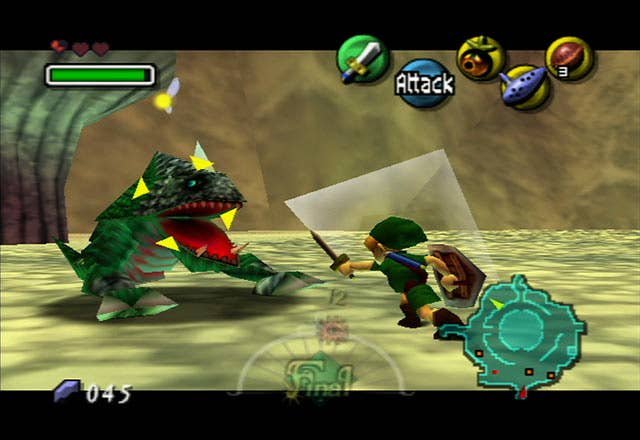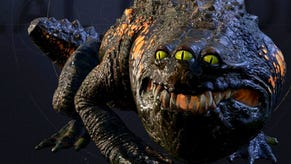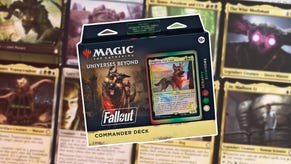10 Video Game Remakes We’d Like to See
USgamer's editors pick 10 classics that could find new life with just a bit of freshening up.
This article first appeared on USgamer, a partner publication of VG247. Some content, such as this article, has been migrated to VG247 for posterity after USgamer's closure - but it has not been edited or further vetted by the VG247 team.
The games industry keeps churning out remakes, but do games as recent and contemporary-feeling as Halo 2 and Fable really need to be revisited yet?
While we wait for those more current games to age a bit, we'd like to offer up some names we'd much rather see revisited modern-style. You know, games that actually merit a facelift. We've each picked a few titles -- what would your choices be?

Pathways Into Darkness (Bungie, 1993), Jeremy Parish
Destiny came from Halo. Halo came from Marathon. And Marathon got its start with an obscure, Macintosh-only adventure called Pathways Into Darkness. Remember how Retro Studios made a big deal about how Metroid Prime wasn't a first person shooter but rather a first-person adventure? Yeah, whatever. Pathways did it first. A complex blend of Ultima Underworld and Sierra-style graphical adventures, this was the world's first glimpse of what Bungie was truly capable of. Players took on the role of a soldier tasked with descending into the labyrinthine passages beneath a Meso-American pyramid where a sleeping god threatened to awaken, at which point it would annihilate all life on earth. Since that wouldn't do at all, your mission was to journey down and detonate a nuclear warhead beneath the god's pillow to send it back to sleep for another millennium.
The mission wasn't quite so simple as that, though. Within the pyramid, you encountered both eldritch horrors spawned from the god's restless dreams as well as the deceitful corpses of previous adventurers, including a bunch of dead Nazis who had ventured here in the ‘40s in search of treasure, power, or both. Just because those who came before were dead didn't mean they didn't have interesting things to say; early on in Pathways you'd gain the ability to converse with the dead, and soon after a fascinating story emerged. But you only had a limited amount of time and ammunition with which to reach the lowest level of the pyramid, set the bomb, and escape to a safe distance. The age of Pathways hasn't been entirely kind to the game, but the concept remains phenomenal, and I'd kill to see a modernized facelift… but not too modern. Much of Pathways' appeal came from exploration and discovering the way forward, and nothing would suck the vitality from this adventure like being reduced to a Call of Duty/Halo-style forced march down a linear corridor.

Xenogears (Square, 1998), Kat Bailey
Xenogears is beloved in many RPG circles, but even its ardent supports have to acknowledge that its largely unfinished. After a rousing first half, much of the second half of the game is told through extended cutscenes, brief gameplay clips, and basic text. It's apparent that there was supposed to be a lot more there, but that director Tetsuya Takahashi and his team simply ran out of time.
One of the reasons that it remains so beloved even now though is just its sheer scope. Few JRPGs even pretend to have the sort of narrative ambition of Xenogears. It's a game that dares to dream. Ideally, a remake would fill out the rest of the story; build upon the interesting but somewhat shallow combat, and further elaborate on the somewhat strange ending. The original is a classic, but there's still a feel of unfinished business about it. A remake would help close that loop, potentially giving us the most epic JRPG ever.

The Legend of Zelda: Majora's Mask (Nintendo, 2000), Bob Mackey
Back when The Legend of Zelda: A Link Between Worlds launched, many people assumed the inclusion of Majora's Mask as a sly background reference meant, without a doubt, that Nintendo had a remake of that specific game in the works. While this assumption can be chalked up to wishful thinking—after all, what Zelda game isn't self-referential—I sure would like Nintendo to breathe some newfound relevancy into the black sheep that won over more critics than fans. I wouldn't want them to change anything about the game per se; while some bits could be made more intuitive, Majora's focus on time constraints offers a tough (but fair) challenge the series hasn't seen since.
The graphics and sound, though, could use a major overhaul, as the newer, darker look for Link and his new friends didn't translate spectacularly to the N64, even with the added horsepower of the RAM expansion pak. If anything, a Majora's remake could bring this alternate take on Zelda to a newer audience—and one that might be growing tired of the series' strict adherence to tradition.

Mercenary (Novagen, 1985), Jaz Rignall
An exercise in design minimalism, Mercenary is an open-ended, non-linear 3D adventure game that was originally released for Atari 8-bit computers in 1985. Taking the role of the eponymous mercenary, you awaken to find you've crash-landed on an alien planet whose inhabitants are at war - and it soon becomes apparent that there's no choice but to become involved.
What transpires is a fascinating mixture of non-linear missions, exploration and political maneuvers as you play one side against the other to achieve your goal of escaping the planet - preferably with as much cash as possible. The backdrop to all this is a barren and minimal landscape that, while sparse, contains many secrets to discover. In a way, it's reminiscent of a very basic Shadow of the Colossus in that despite almost no action taking place between set pieces, its environment is nevertheless incredibly atmospheric and begs to be explored.
If Mercenary were to be remade today, it would be difficult to resist adding many layers of additional complexity to its story - but I think that doing so would be a mistake. Instead, give its key set pieces some real oomph, and expand its landscape and make it even more mysterious by adding more interesting things to discover, and I think you'd have a game that maintains the spirit of the original, while feeling very contemporary. Almost like a sci-fi version of Shadow of the Colossus - which I think would be irresistible.

Gargoyle's Quest (Capcom, 1990), Mike Williams
I doubt a ton of people remember this series; I know I fell into it completely by accident. My father bought me the first Gargoyle's Quest to the original GameBoy and at the time, I hated it. The game was painfully hard for my child self, like a number of other Game Boy titles. I can't say I appreciated it the first time around.
The entire series is an odd mix of Final Fantasy-style overworld, platforming action, and RPG elements. In fact, the original and its sequel played a great deal like Zelda II: The Adventure of Link, with a far cooler protagonist. Gargoyle's Quest II for NES improved on the original with more of everything, while Demon's Crest for Super Nintendo shifted towards a stronger Castlevania feel. It wasn't until playing Demon's Crest that I had the desire (and capability) to go back to the older games and see what my younger self missed.
I want this series back because that open-world/platformer/RPG mix hasn't really been brought forward into the modern era, even via spiritual successor on Kickstarter. Each game is just a bit different, I think a compilation bringing all three games up to the same graphical level while keeping most of their systems intact would be much appreciated.

Metroid II - Return of Samus (Nintendo, 1991), Jeremy Parish
When Metroid: Zero Mission came out 10 years ago (oh my god, has it been 10 years!?), remaking the original Metroid in brilliant style, our thoughts drifted immediately to the sequel. If any Metroid could use a remake, it's the second one. The original version pushed against the suffocating limitations of the Game Boy hardware with admirable vigor, but it definitely suffered from technological impositions, feeling at once cramped and linear. Despite being the most straightforward Metroid ever, it often became confusing because of the muddy graphics and crowded screen dimensions. Meanwhile, Metroid Fusion included a number of brilliant Metroid II callbacks, offering a tantalizing hint of what its world could have been like with greater freedom and fidelity.
So imagine a Zero Mission-style recreation of Metroid II, with a bigger, more complex, more thoughtfully designed world. Imagine what all of those subterranean caverns would look like in full color. Imagine if the Omega Metroid we faced at the end of Fusion weren't a final boss, but rather one of several intensely deadly encounters leading up to the endgame -- and if the Alpha, Gamma, and Zeta Metroids were similarly reworked to be more than missile-sponge battles of attrition. It's easy if you try… especially since a dedicated fan has been working on creating precisely that practically since Zero Mission debuted. But wouldn't it be nice if Nintendo gave fans what they wanted, too?

Monster Rancher (Tecmo Koei, 1997), Bob Mackey
Once upon a time, music came on these things called "compact discs" that cost upwards of $20 and typically included 7-8 songs we wouldn't listen to more than a few times. Needless to say, we purchased untold millions of them. Tecmo's Monster Rancher took advantage of this abundance by giving us a reason to dig through the uncharted regions of our CD wallets—each individual disc would spawn a unique monster within the game. CDs might be a thing of the past, but that doesn't mean the real-world hook of Monster Rancher needs to disappear forever. Our physical realities are still full of stuff that can be scanned (from wi-fi signals to UPCs to QR codes) to generate fearsome and marketable digital creatures, so there's no reason Monster Hunter has to die just because Virgin Megastores now house more feral raccoon colonies than physical media.

Rescue on Fractalus (Lucasfilm Games, 1984), Jaz Rignall
Fractal terrain demo.Also known as Behind Jaggi Lines, this was quite probably the coolest game of 1984. Created by Lucasfilm Games for Atari 8-bit computers and Commodore 64, Rescue on Fractalus puts you in the seat of a search and rescue dropship on a mission to save pilots who've crashed on a hostile alien planet.
What makes the game so notable is that it uses fractal technology to render the planet's surface, creating an environment that was like nothing else at the time. Flying over and around mountains trying to locate crash sites was truly exciting, even if it does look slow and fugly by today's standards. However, having recently seen some very impressive modern fractal graphic demos, it's clear that an updated version of the game could be made that would be astonishing to look at.
Rescue on Fractalus' original gameplay could be beefed up with a variety of interesting missions, almost like the old-school Microprose flight sims that featured a mixture of shooting, reconnaissance, search and rescue, objectives against the clock, and harsh environmental challenges. That combined with realistic-looking alien planets to fly over would be an appropriate homage to the original while bringing its original spirit and sensibilities bang up to date.

X-wing vs TIE Fighter (LucasArts, 1997), Kat Bailey
It's sort of ridiculous how far ahead of its time the original X-wing vs. TIE Fighter was. In an age when even the 56k modem had yet to really gain a foothold in the U.S., Lawrence Holland envisioned a game in which up to eight players could work together to complete missions against the A.I. or engage in large dogfights. It was an admirable idea, but the online infrastructure of the time just wasn't up to it. X-wing vs. TIE Fighter relied heavily on Microsoft's Internet Gaming Zone for its matchmaking—a browser-based solution that often slowed the game to the crawl. And the netcode was no great shakes either. Even now, X-wing vs. TIE Fighter suffers from grievous latency.
For that reason, XvT is a perfect candidate for a true 2015 remake (the now defunct Star Wars: Attack Squadrons doesn't count). With a rebuilt engine, an increased player count (imagine a 64-player Battle of Endor), and a handful of new missions, X-wing vs. TIE Fighter could potentially be a hit as a download-only title on Steam. It may only be a pipe dream; but for Star Wars fans who cut their teeth on X-wing and TIE Fighter in the early 90s, a remake would be a huge cause for celebration.

Star Wars - Knights of The Old Republic (Bioware, 2003), Mike Williams
This was my first real Bioware game, folks. I had a PC, but Dungeons & Dragons was never my thing, so Baldur's Gate and Icewind Dale were games I heard of, but never played myself. On other hand, I'm an avid Star Wars fan, so when the words “Star Wars" and “RPG" were brought together, I purchased the game sight unseen. Lo and behold, it was good. Really, really good.
I'd argue that Knights of The Old Republic was the beginning of current, mainstream Bioware. Launching that game on Xbox put them on the map, and everything since has been an evolution of that starting point. Certain older Bioware games had elements of the formula here and there, but KOTOR was when it was brought together in one amazing game.
Last year was the game's 10-year anniversary, so EA and BioWare have missed the boat on having a timed HD remake, but if any game deserves an HD polish, it's this game. The PC version has improved graphics, but the game really need to be redone top-to-bottom. New models, new textures, the whole thing. Make it happen, BioWare.








